Did you know that with an evaporative cooler you can enjoy the benefits of an air conditioner without the added expenses and complicated installations? By choosing the best evaporative cooler for your area size and needs, you can save money on your electric bill and enjoy fresh cold air in the dry and hot summer months.
There are many more unique benefits to having an evaporative cooler. They offer much more than cold air. A quality evaporative cooler also plays the role of a humidifier, and some come with filters that help clean air of airborne particles. To make it all easy for you, we’ve compiled evaporative cooler reviews so check them out.
See The Quick Comparison Chart
What is an Evaporative Cooler?
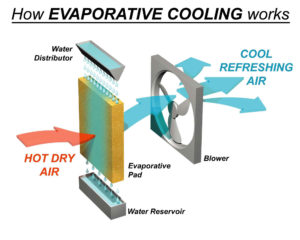
Evaporative cooling works by taking in warm or hot air to filter it through wet pads and quilts. As the water evaporates from the pads, the fan sends the cold air and then back out into the area. Basically, it takes warm air surrounding it and produces cool are via evaporation, then blasts it out. As long as the water container is never empty and there’s fresh air around the cooler, it will work.
Why You Need an Evaporative Cooler
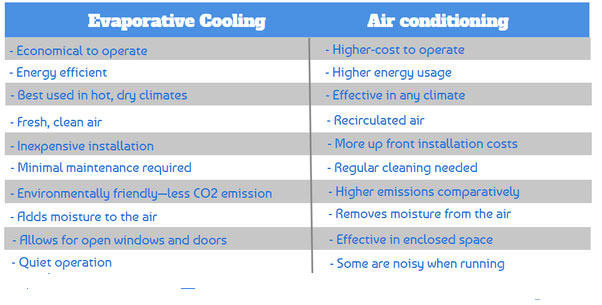
Simple Cooling Tech
Unlike standard air conditioners that use refrigerants and compressors, evaporative coolers only need water. The cooler itself consists of cooling pads that get wet, a pump, and a fan to blow the cold air. Most of them do not even have a filter to clean and worry about. Just make sure there is water in it, and you are set.
Inexpensive and Cost-Effective Operation
Not only are they much cheaper to buy than an air conditioner, but they operate using very little electricity. A typical 36-inch cooler that runs 8 hours usually doesn’t cost more than one dollar. This cost is just electricity for operation and the added water. An air conditioner requires a lot more power, and usually, an evaporative cooler can cost up to, or more than 50% less. Since we at HomeClimate are big on cost-effective heating and cooling, don’t forget to check out our reviews on top-rated portable car heaters. They do the opposite of the coolers but will be of significant help to you and your car trips during the winter.
Eco-Friendly
This is the ideal choice for environmentally-conscious consumers. They are a fantastic solution to stay cool without using refrigerants. They operate through a completely natural process of combining water with motion. There are no added pollutants or chemicals that could be harmful to the environment.
Double as a Humidifier
The reason that evaporative coolers are suitable only for dry climates is that they use the power of evaporation to cool air. This means that dry air is humidified in the process. If you experience itchy skin, throat, or eyes due to dry air, you can take advantage of this added benefit.
Lastly, one of the most significant benefits is that you are not circulating the same air as with air conditioners. To get the best results from the cooler, a window or door must be opened to reduce the buildup of too much moisture. They cool the fresh air and release it into the area. With air conditioners to work, it is necessary to have an airtight space, or else they could get damaged.
Best Evaporative Coolers Comparison Chart
| PRODUCT | DETAILS | |||
|---|---|---|---|---|
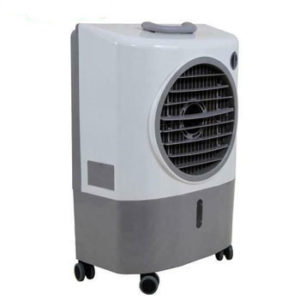 | Hessaire Products Evaporative Cooler |
| View On Amazon | |
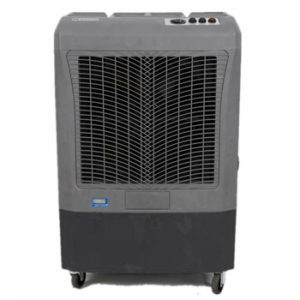 | Hessaire Portable Evaporative Air Cooler |
| View On Amazon | |
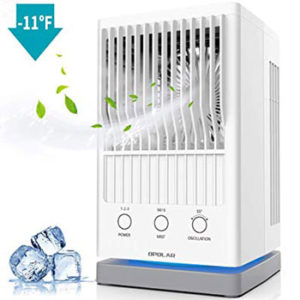 | Be1 Mini Personal Air Conditioner Fan |
| View On Amazon | |
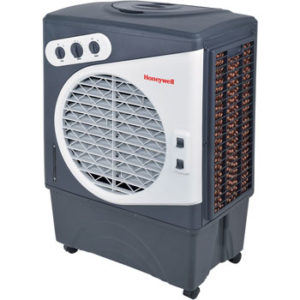 | Honeywell Outdoor Portable Evaporative Cooler |
| View On Amazon | |
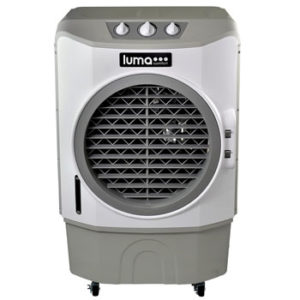 | Luma Comfort High Power Evaporative Cooler |
| View On Amazon | |
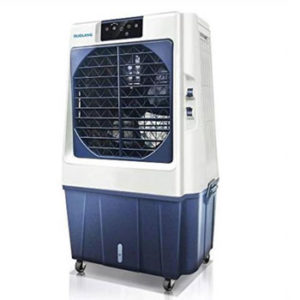 | DUOLANG Outdoor Portable Evaporative Air Cooler |
| View On Amazon | |
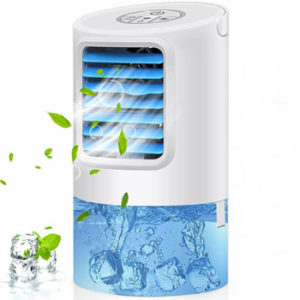 | GREATSSLY Mini Personal Evaporative Air Cooler |
| View On Amazon |
Best Evaporative Coolers – Editors’ Choice
Below you will find the top-rated coolers on the market in a range of sizes and prices in no particular order.
1. Hessaire Products Evaporative Cooler
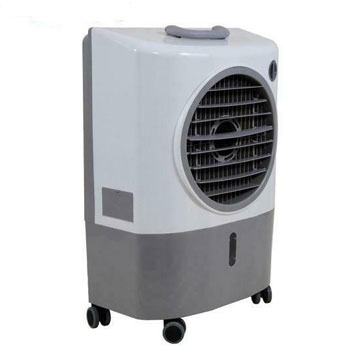
It features a high-density grid media pad and a handle and wheels for mobility to use indoors or outdoors. With four speeds, 1,300 CFM, and hi-density el50 rigid media, it will provide an 80% wider evaporation surface for better cooling. It is manual water fill, and the water levels are easy to read.
Pros:
- It offers 3-4 hours operation on a full tank of water.
- It is effortless to set up, fill, and use.
- One of the least expensive options for size and quality.
Cons:
- It is rather noisy even at the lowest level.
- The cooler doesn’t oscillate up/down or left/right.
2. Hessaire Portable Evaporative Air Cooler
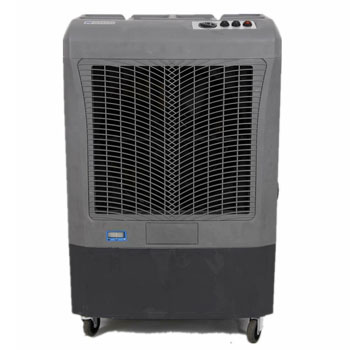
It is the most efficient cooler for its size. Its oscillation louvers offer more extensive coverage while operating quietly. You can adjust the cooler between 4 temperature settings and control the oscillation for better results. The high-velocity Avial fan blade is made of heavy-duty material, while the Xel50 cooling pad offers maximum cooling. Attach to the garden hose for continuous water refilling.
The cooler has 3 media panels that improve air intake and lower static pressure. It is the ideal cooler for outdoors due to its made of polypropylene resin for added durability and endurance.
Pros:
- The tank is straightforward to fill, and the evaporative cooler easy to use.
- Powerful results that can be felt from far.
- A vast reservoir (10.3 gallons) allows for more extended periods before refilling.
Cons:
- The cooler is bulky and not very suitable for all areas.
- The wheels don’t seem to be made very well and could break easily.
3. Be1 Mini Personal Air Conditioner Fan
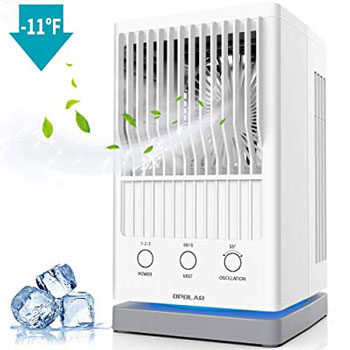
The cooler features a 550 mL capacity and offers space for ice for added cooling. It has a 55-degree wide oscillation coverage and 2 spray modes, intermittent and continuous. What we liked most is that it is USB powered, making it very versatile as this makes it very energy efficient. It can be connected to your laptop, PC, power strip, USB hub, or power bank. It comes with a 3.28 foot long USB cable.
The cooler works very quietly and cools utilizing a fan and water mist up to 2-4 hours continuous spray with a full tank. It consumes no more power than a lightbulb would. The Be1 features 3 power speed settings and comes with a 1-year warranty for a defective item.
Pros:
- LED light for indicating that the water level is low is beneficial.
- We were happy how effective it was in close proximity.
- The oscillating feature is handy and practical.
Cons:
- The USB cable is rather short, making it difficult to place anywhere.
- Water spills if you move it, so keep a towel nearby.
4. Honeywell Outdoor Portable Evaporative Cooler
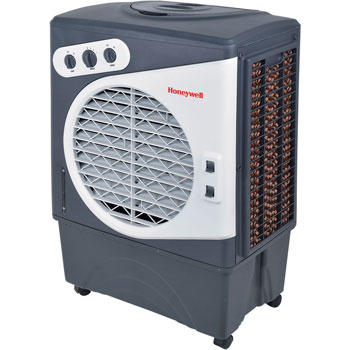
If outside, simply attach it to the garden hose for continuous water supply, or refill through the top water inlet compartment. It doesn’t throw any water mist, and the body is UV and weather-resistant, making it ideal for outdoor use.
It features triple sided Honeywell Honeycomb cooling pads for added evaporation and cooling. For easy maneuverability, it features durable wheels and is 18.35 x 27.56 x 40.04 in size. Manufacturers claim the cooler is very quiet at 65dB at high speed.
Pros:
- We are happy that it is very quiet.
- It features an attractive design, making it a great addition to the interior or exterior.
- Super powerful and effective in changing air temperature in the vicinity of the cooler.
Cons:
- There is no auto shut-off when the water runs out.
- There is a bad odor that comes out of the cooler for several days after first use.
5. Luma Comfort High Power Evaporative Cooler
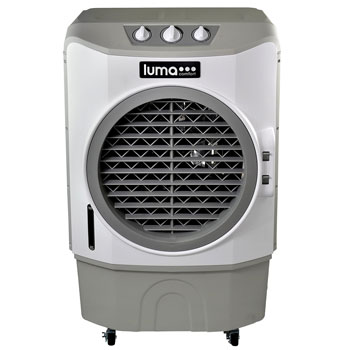
The cooler features 3 cooling speeds and four wind modes, covering 650 square feet of cooling power. It works on 120 volts and has an extra-large 5-gallon water tank and cooling pad. You can quickly move it anywhere you need it, indoors or outdoors, and is very easy to fill.
There is space for ice packs and has a filter for airborne particles for added air cleaning. The construction is of UV protected ABS plastic that won’t crack or corrode. You can connect it to the garden hose for continuous filling and 1650 CFM cooling. A full tank can last approximately 6 hours.
Pros:
- The cooler has a filter for added function for cleaning the air of airborne particles.
- For added ease of use, it features a remote control.
- It is very effective and powerful.
Cons:
- The wheels are set to point in only one direction, making it impossible to roll it sideways.
- The water level indicator is tough to read.
6. DUOLANG Outdoor Portable Evaporative Air Cooler
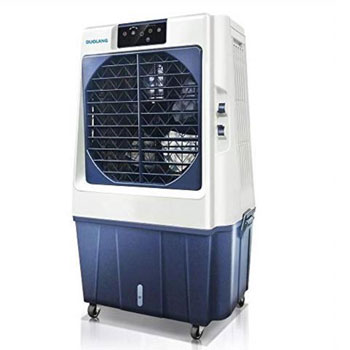
This is the only cooler that features a timer. It also comes with remote control for ease of control of the fan blade from a distance. The unit also features an LED display as well as a dust filter that doubles as an air purifier. Maneuver it anywhere, indoors or outdoors, via the durable wheels.
The honeycomb cooling pad allows for 1353 CFM airflow cooling that covers up to 645.8 square feet. It has four modes and three-speed levels. It is a 4 in 1 unit that can be used as a fan, air purifier, air humidifier, and air cooler. The oscillating louver is easily adjustable to point wherever you need.
The removable 15.9-gallon water tank can be taken out when not in use and used for storing the cooler.
Pros:
- The cooler comes with remote control.
- It has a dust filter and can double as an air purifier for larger particles.
Cons:
- The cooling abilities leave something to be desired.
- There is no warranty information.
7. GREATSSLY Mini Personal Evaporative Air Cooler
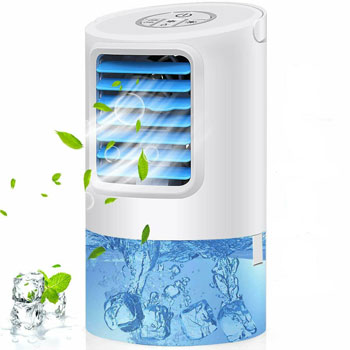
The water tank holds 400 ml of water and can work up to 3-4 hours. The small cooler can be used not only to cool you but also as a humidifier and purifier to catch larger particles such as pet hair and dander. It is only 8.9 inches high, making it very space-efficient and portable. This is a new evaporative cooler model that gives a lot of options.
This feature-packed mini cooler has a handle for easy carrying, a timer, a 120-degree fan outlet angle adjustment, and full control over the lights. You can turn them on or off, change the color, or select color strobe. It comes with a 1-year warranty.
Pros:
- Features 7 LED lights to double as a nightlight.
- The water tray is easy to access and clean.
- Very small and space-efficient.
Cons:
- The cooler isn’t very effective and you must be right next to it to feel anything.
- Not an evaporative cooler as it doesn’t have pads for collecting water in order to blow cool evaporated air out.
What Climate Should You Use an Evaporative Cooler In?
Before you start your search you need to know when you should buy an evaporative cooler. It is essential to know if you live in the right environment based on humidity and air temperature, so you don’t waste your money.
The air temperature and humidity where you live will determine if your cooler will work properly or not. Coolers work best in certain temperatures and humidity levels, as you can see in the chart. But before reading into it, let’s review the two key terms.
Air Temperature
This is a standard thermometer reading of the temperature without any other factors put into consideration. However, just the temp alone won’t be enough to know if an evaporative cooler is ideal for you.
Relative Humidity
The relative humidity is measured as a percentage that expresses how saturated the air is with water. Hot air can hold more water than cold air, so the same amount of humidity — also known as absolute humidity — on a cold day will feel more humid than it would on a hot day.
This is basically how saturated the air in your area is with water. Cold air holds less water than hot air. The relative humidity is a percentage that is calculated based on the amount of moisture that’s in the air and is compared to the maximum amount of moisture air can hold. The higher the humidity, the harder it is for water to evaporate, the lower the humidity, the faster and easier water evaporate.
This is why it is crucial to use an evaporative cooler in areas with hot and dry weather instead of areas high in humidity. The water simply won’t be able to evaporate and all you end up with is a fancy fan.
Reading the Temperature/Humidity Chart
Today everyone has a smartphone or a computer nearby. You can check the air temperature and humidity anytime. Check the numbers in your area and use the chart to decide if you fall in the optimal conditions for owning an evaporative cooler. To use the table, simply follow the temperature in your area and intersect it with the relative humidity. This place where they intersect will tell you what temperature you can expect by running an evaporative cooler.
The figures highlighted in green are the ideal combinations of humidity and air temperature. You will still get results if you are slightly out of the green, but don’t stray too far to avoid disappointment.
Should You Buy an Evaporative Cooler?
Although the chart above will give you an idea of whether the cooler will work on that particular day, it’s vital to know whether it will be sufficient. Knowing if the area you live in fits within the standard requirements helps a lot.
Generally, you can find averages per year and season of both humidity and temperature. Consider what months you will most likely be using it and use those figures in the chart above. If you don’t want to waste time on that, simply consider this:
The further west you are on the US map, the more effective the cooler will be as air out west is drier. The climate in the west is less humid and warm months are arid, allowing for more evaporation. On the other hand, if you live on the east coast, especially down south where it is very humid, an evaporative cooler may not be the best choice for you.
Indoor Use of Evaporative Coolers
Although very effective in changing the air temperature, there are some things to consider if you plan on using your evaporative cooler indoors.
Right-sized Cooler
Make sure that when you purchase you choose a cooler that perfectly fits the size of the space you want to use it in. A larger than the space cooler isn’t a significant problem, but if you choose one too small, it will have little to no effect on the large area.
Fresh Air Supply
As we mentioned above, these coolers humidify the air. If you don’t have a fresh air supply in the room, the humidity will get too high, rendering the cooler ineffective. The best way to do this is by leaving a door or window open that allows the humid air to escape and lets fresh air in. Placing the cooler right under a window or near an open door makes it even more useful.
Maintenance
Wherever there’s water involved, so is stink if not cleaned regularly. Clean out the water tray and cooing pad often. Wipe down the insides and make sure you don’t leave water in the system too long. Always pour excess water out, preventing the buildup of algae and bacteria.
There are also a variety of whole house coolers available that have more permanent installations.
Using Evaporative Coolers Outdoors
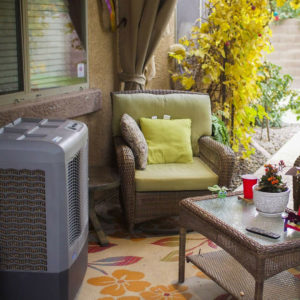
The evaporative cooling process will be more effective due to the open space allowing the cooler to blow cold air in the area where you are. Indoors the cold air is kept in by the roof and walls. However, outdoors it spreads out much faster and dissipates. This is why the spread of the cold air will be smaller than indoors.
Understanding Evaporative Cooler Sizing
When shopping for an evaporative cooler you will often see CFM in the description. CFM means cubic feet per minute or the amount of air that is cycled through the area where the cooler is per minute. Choosing the correct cooler to fit your space is crucial to getting results.
Here is an example of calculating the size cooler you need:
- Square footage of room: 100 square feet
- Height of ceiling: 9 feet
To get cubic feet you need to multiply the square footage of the room and the height of the ceiling. In this case, the cubic feet are 900 (100 square foot room x 9 foot high ceilings).
To calculate CFM, divide cubic feet by 2, where 2 is the number of times the air will be cycled.
So 900 cubic feet/2 is 450. The CRM you will be looking for is 450. It’s no problem if it is bigger than the area, but it certainly cannot be smaller if you want to get results.
If you have your heart set on one, it is essential to know how to size an evaporative cooler, so you get the results you want.
Unique Features of Evaporative Coolers to Look for
Aside from merely cooling, many additional features could further add to the convenience. As with any other home appliance, there is always room for improvement, and these added features are just that. When shopping for a cooler, keep some of these features in mind for added convenience.
Multiple Fan Speeds
Select how cool you want to be in the area and how strong you want the fan to blow. Most coolers come with three speeds, but there are some with four to six-speed options. Just keep in mind that the higher the rate, most likely the louder the cooler will get.
Oscillating Louvers
Rather than blowing in one direction, some coolers offer oscillating louvers. Some are automatic, while others have controls. If this is a feature you want, make sure to check the direction and degrees of oscillation.
Digital Display
The more technologically advanced coolers offer digital controls and screens to set more specific temperatures, speeds, and oscillation. The displays give more insight into the length of operation before you need to add water, and much more.
Filling Options
The one thing you do have to do with evaporative coolers is to make sure there is always water for them to work. If a cooler is left without water and doesn’t automatically stop, it may burn the pump. Some coolers have hose hookups, top or side filling, while others feature removable water containers that can quickly be taken to be refilled. Consider what would be most comfortable and select one that would be most convenient.
Automatic Shut-Off
This is a pretty convenient feature to have if you plan on using the cooler in the bedroom at night. As mentioned above, if a cooler is left running without water, it can burn the pump. Whether you forget to turn it off or use it while sleeping, it ensures your cooler is safe if the water runs out.
Space for Ice
To get a boost in speed and power of cooling you can add ice. There are many coolers manufactured these days that offer individual compartments for this to get the best effect.
Remote Control
Today many evaporative coolers come with remote control for regulating the temperature, fan speed, and oscillation from a distance.
Timer
This is a great added feature for conserving energy as well as protecting the evaporator from operation without water. You can set the timer for it to turn on and turn off at set times throughout the day.
Air Filter
As the evaporative cooler works by sucking in air, running it through cold evaporated water, and releasing it back into the area, many now come with a filter. The filter can capture larger dust and allergen particles and clean the air as well. There are even activated carbon filters that also capture odors.
Find more useful HomeClimate guides and reviews on a variety of fantastic products and solutions for improving air quality, heating, and cooling by looking at our home page. Our experts carefully review each product and gather real user experience feedback to present to you only the top products currently on the market.
Outdoor Installation of Evaporative Coolers
The installation of evaporative coolers is relatively simple. Just connect your evaporative cooler to an electricity source and add water. You may also connect it to a water source if it has a garden hose connector. Some even have drains for wastewater.
Placement
When using the cooler outdoors it’s better to place it in a partially enclosed space. A patio with at least one or two walls and a roof is ideal. This way less of the cold air will escape, and there will still be plenty of evaporation to prevent humidity buildup.
Place the cooler on level ground and prepare all of your connections. First, connect it to the water source or fill it with water. Each cooler has specifics as to where the garden hose hookup is and attachments. Refer to your instructions booklet that came with the cooler to hook it up to your garden hose.
Hooking Up
Before hooking the cooler up to the electric source make sure you first connect it to the water source and fill it to make sure there are no leaks. Then connect it to your power source and make sure your electrical connections are waterproof, and you use grounding to prevent electric shock.
Some coolers have a pre-cooling setting that allows it to start running straight away. If yours does not, you will need to run the cooler a few minutes before you begin to feel results. During this time the pump will prime and will fill the cooling pads with water.
Storage
Unless you plan on using your cooler again soon, you will need to run it a couple of minutes without water before storage. This will allow water from the pumps to drain and prevent the buildup of bacteria from damp pads being stored.
Indoor Installation of Evaporative Coolers
Most likely you won’t be hooking up your cooler to a direct water source when using it indoors, so first make sure you’ve filled up the water tank. Connect the cooler to the electricity and allow it to prime. There is very little difference in setup until this point. What is different is that you must enable ventilation if you will be using the cooler inside as it will cause moisture buildup.
Here are some positions for the cooler and options for ventilating the indoor space:
- Place the cooler near an opened window with its back to it for better ventilation. Ensure there is a power outlet nearby and position it as close as possible to the window.
- If there is no way to place by a window, put it wherever it is most comfortable and open two opposite windows or doors. This allows for good airflow to prevent stagnant moist air buildup.
- To prevent cold air from escaping, but allow enough airflow to prevent moist air buildup, you can fully open a window or door on one side, and directly opposite have another window or door partially opened. This will cause a steady stream of fresh air.
- For two-story homes, you can create a chimney effect by opening a window upstairs and one downstairs. Hot air goes up, so top levels are usually much warmer. This natural airflow between the two opened windows on opposite sides of the home will help push the hot air out of the second floor and bring more cool air from the cooler up.
- Add ice for a faster and stronger cooling effect. If you are in dire need of cold air you can boost the impact of the cooler by adding ice either to the specified compartment or direct in the water container.
Overall, make sure that there is proper ventilation to prevent a mucky feel in the area due to the buildup of moisture. Another fantastic way to improve ventilation is by installing window fans. Take a look at our window fan reviews for more information, buying guide, and reviews of the top products.
Proper Maintenance of your Evaporative Cooler
Maintaining your cooler will not only ensure it works longer, but it will guarantee that the air that you breathe is clean and odorless. If stagnant water is left in the cooler, it will collect bacteria and mold and start to smell.
Maintenance tips for when storing your cooler away at the end of the season
- Make sure that the cooling pads are completely dry.
- Drain water from the reservoir and run the pump for a few minutes to get the water out of it.
- Remove the cooling pads and wipe down the inside of the cooler and the reservoir.
- Replace the cooling pads and put the cord away.
- Store the cooler in a dry place away from the elements.
- If you have a protective cover for the cooler, cover it. If not, you can use any tarp to cover the cooler and protect it from dust and debris.
Maintenance tips for when taking the cooler out for the warm season
- First, look over the cooler to make sure nothing is broken, missing, or needs replacement.
- Check that the fan moves freely.
- Look over the water reservoir and remove cooling pads to wipe down of any dust or debris buildup.
- Replace cooling pads and start the installation process.
Each cooler will come with a manual containing information on how to get the best out of your evaporative cooler. Follow these instructions carefully to prevent damage to the cooler as well as ensure it continues to work correctly for years to come.
Wrap up
With very little maintenance, low cost, and low usage expenses, evaporative coolers are the ideal choice for eco-conscious users. They are an effective way to cool those hot dry summers both indoors and outdoors.
Find the best evaporative cooler to suit your needs and fit the area you want to cool by following our simple buying guide. There are many impressive options available, from large coolers suitable for cooling vast areas, to small desktop coolers to give you your personal climate when at work. We’ve provided a variety of options in our evaporative cooler reviews.
Share your thoughts, feedback, and experience with your cooler in the comments below, and feel free to ask any questions you may have about evaporative coolers.
Thanks for reading and as always – stay put! We have also covered many other product reviews ranging from the best air purifiers for mold to top-notch pellet stoves.
Leave a Reply